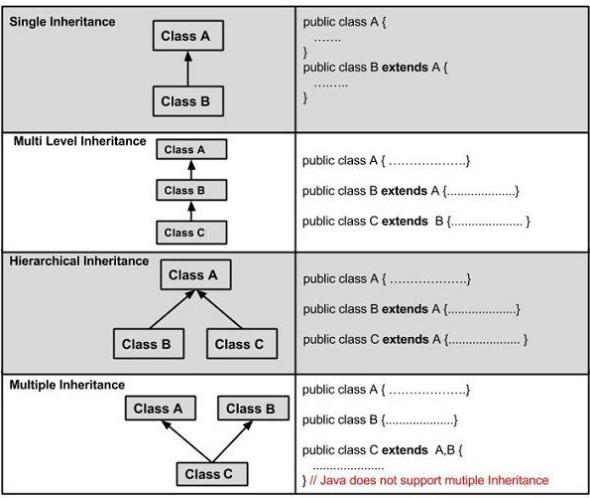Inheritance is an important pillar of OOP (Object Oriented Programming). It is the mechanism in java by which one class is allowed to inherit the features (fields and methods) of another class. The process by which one class acquires the properties (data members) and functionalities(methods) of another class is called inheritance.
The aim of inheritance is to provide the reusability of code so that a class has to write only the unique features and the rest
of the common properties and functionalities can be extended from another class. The idea behind inheritance in Java is that you can create new classes that are built upon existing classes. When you inherit from an existing class, you can reuse methods and fields of the parent class. Moreover, you can add new methods and fields in your current class also.
Terms used in Inheritance
- Class: A class is a group of objects which have common properties. It is a template or blueprint from which objects are created.
- Sub Class/Child Class: A subclass is a class that inherits the other class. It is also called a derived class, extended class, or child class.
- Super Class/Parent Class: Superclass is the class from where a subclass inherits the features. It is also called a base class or a parent class.
- Reusability: As the name specifies, reusability is a mechanism that facilitates you to reuse the fields and methods of the existing class when you create a new class. You can use the same fields and methods already defined in the previous class.
The syntax of Java Inheritance
class Subclass-name extends Superclass-name
{
//methods and fields
}
The extends keyword indicates that you are making a new class that derives from an existing class. The meaning of "extends" is to increase functionality. In the terminology of Java, a class that is inherited is called a parent or superclass, and the new class is called a child or subclass.
Types of inheritance in java
On the basis of class, there can be three types of inheritance in java: single, multilevel, and hierarchical. In java programming, multiple and hybrid inheritance is supported through interface only.

1. Single Inheritance
Single Inheritance refers to a child and parent class relationship where a class extends the another class
class Animal{
void eat(){
System.out.println("eating...");
}
}
class Dog extends Animal{
void bark(){
System.out.println("barking...");
}
}
class TestInheritance{
public static void main(String args[]){
Dog d=new Dog();
d.bark();
d.eat();
}
}
Output:
barking...
eating...
2. Multilevel Inheritance
Multilevel inheritance refers to a child and parent class relationship where a class extends the child class. For example, class C extends class B and class B extends class A.
class Animal{
void eat(){
System.out.println("eating...");
}
}
class Dog extends Animal{
void bark(){
System.out.println("barking...");
}
}
class BabyDog extends Dog{
void weep(){
System.out.println("weeping...");
}
}
class TestInheritance2{
public static void main(String args[]){
BabyDog d=new BabyDog();
d.weep();
d.bark();
d.eat();
}
}
Output
weeping...
barking...
eating...
3. Hierarchical Inheritance
Hierarchical inheritance refers to a child and parent class relationship where more than one classes extends the same class. For example, classes B, C & D extends the same class A.
class Animal{
void eat(){
System.out.println("eating...");
}
}
class Dog extends Animal{
void bark(){
System.out.println("barking...");
}
}
class Cat extends Animal{
void meow(){
System.out.println("meowing...");
}
}
class TestInheritance3{
public static void main(String args[]){
Cat c=new Cat();
c.meow();
c.eat();
//c.bark(); //Error //To access property of class Dog create object of class Dog
Dog d=new Dog();
d.bark();
}
}
Output
weeping...
barking...
eating...
4. Multiple Inheritance
When one class extends more than one classes then this is called multiple inheritance. For example: Class C extends class A and B then this type of inheritance is known as multiple inheritance. Java doesn’t allow multiple inheritance. We can use interfaces instead of classes to achieve the same purpose.